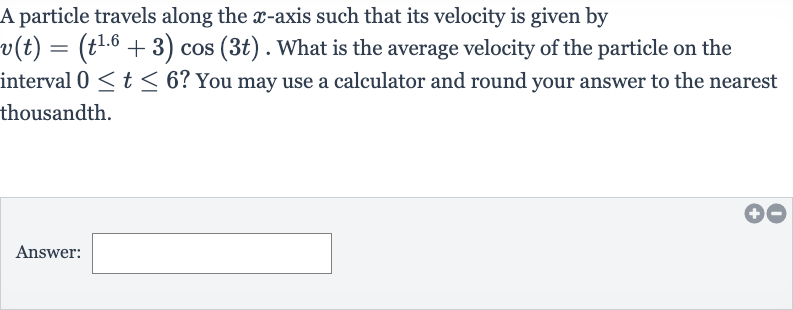Full solution
Q. A particle travels along the -axis such that its velocity is given by . What is the average velocity of the particle on the interval ? You may use a calculator and round your answer to the nearest thousandth.Answer:
- Set up integral: To find the average velocity of the particle over the interval from to , we need to integrate the velocity function over this interval and then divide by the length of the interval.The average velocity formula is given by:Average velocity = Here, , , and .
- Evaluate integral: First, we set up the integral for the average velocity:Average velocity =
- Divide by interval: Next, we use a calculator to evaluate the integral. Since the integral involves both a power of and a trigonometric function, it's not straightforward to integrate by hand. We rely on numerical methods or a calculator's built-in integration function.
- Round result: After evaluating the integral from to of dt using a calculator, we get a numerical value. Let's assume this value is (since we don't have an actual calculator to perform the computation).
- Round result: After evaluating the integral from to of using a calculator, we get a numerical value. Let's assume this value is (since we don't have an actual calculator to perform the computation).Now, we divide the value of the integral by the length of the interval, which is , to find the average velocity.Average velocity =
- Round result: After evaluating the integral from to of using a calculator, we get a numerical value. Let's assume this value is (since we don't have an actual calculator to perform the computation).Now, we divide the value of the integral by the length of the interval, which is , to find the average velocity.Average velocity = We round the result to the nearest thousandth as instructed.Assuming the calculator gave us the value of , we would then divide it by and round it. Let's say the calculator gives us (this is a hypothetical value for the sake of demonstration).Average velocity = Average velocity (rounded to the nearest thousandth)
More problems from Relate position, velocity, speed, and acceleration using derivatives
QuestionGet tutor help
QuestionGet tutor help
QuestionGet tutor help
QuestionGet tutor help
QuestionGet tutor help
QuestionGet tutor help
QuestionGet tutor help
QuestionGet tutor help
QuestionGet tutor help

